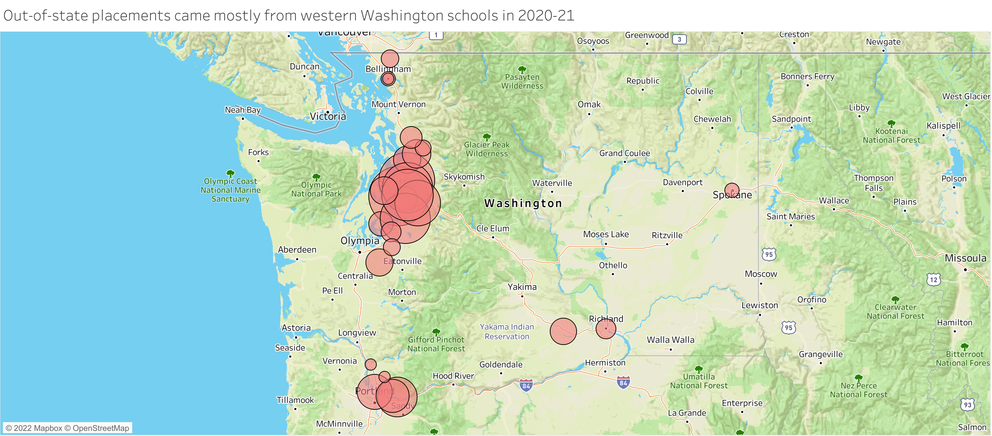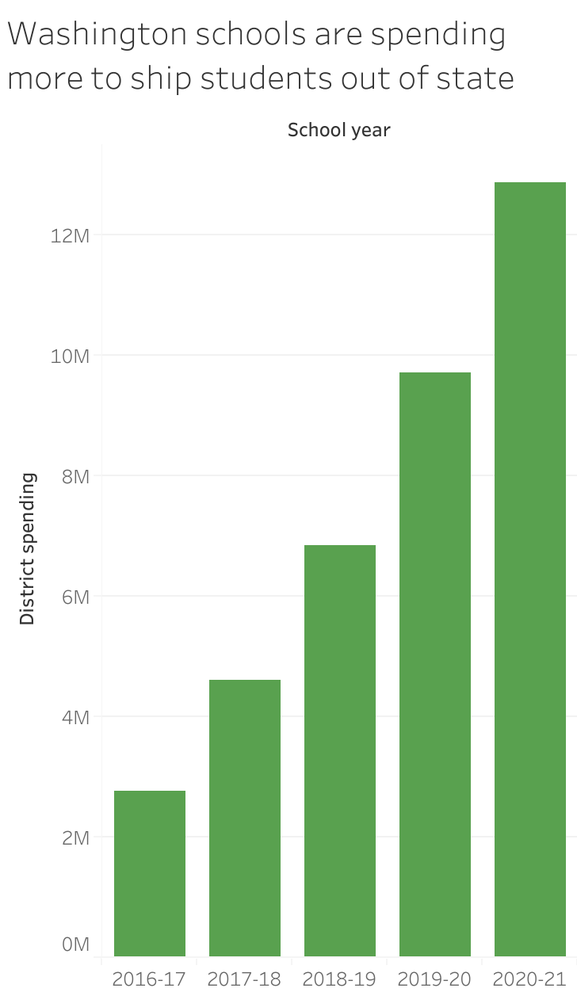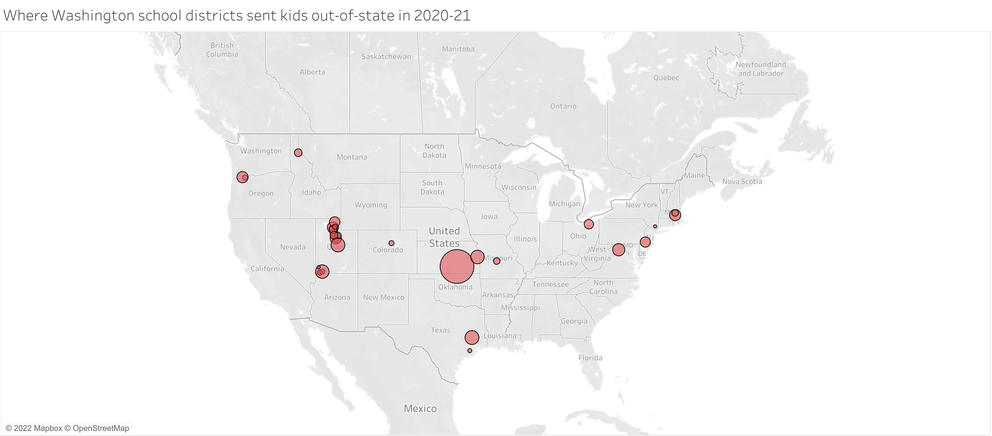“It was a very tough decision for me,” says Haile, a 40-year-old King County Metro driver. “But I had no choice. Nobody could find anything in Washington state.”
InvestigateWest is an independent news nonprofit dedicated to investigative journalism in the Pacific Northwest. Visit invw.org/donate to support this kind of in-depth reporting.
For families in Washington, it’s an increasingly common problem. During the 2020-21 school year, school districts in Washington sent 80 students to out-of-state facilities, according to public records from the state Office of Superintendent of Public Instruction. That’s nearly four times as many Washington kids sent out of state as during the 2016-17 school year, data show, although the state agency says part of the increase reflected in the data may be a result of better tracking in recent years.
School districts send students to out-of-state facilities if they do not have the resources to provide services for children with complex needs, typically resulting from disabilities or childhood trauma. But doing so can be costly. In total, those 80 students sent out of state last year cost school districts nearly $13 million, according to state data. And the actual amount of spending may be even higher, since the data from the state show only costs that districts asked to be reimbursed for.
A spreadsheet of these placements, obtained by InvestigateWest, shows which districts most frequently ship students out of the state, and where those placements are. Almost exclusively, it was schools west of the Cascades paying to send students to facilities as far away as Utah, Kansas or Massachusetts.
Advocates for kids with disabilities say they’re alarmed at how many students are being sent away from Washington. They argue it highlights a growing crisis, underscoring the lack of options for people with disabilities and the need for Washington lawmakers to invest more into special education so students can stay in school at home.
“This signals loud and clear that we need to spend more time thinking about solutions that are here, so that families aren’t in crisis, kids aren’t in crisis, and we’re not separating them during this time,” says Stacy Dym, executive director of the Arc of Washington, a nonprofit organization advocating for people with intellectual and developmental disabilities.
Families, meanwhile, are left to comfort children they may not see for months at a time. Haile tries to visit and Zoom with Leoul as much as she can, but it’s hard to tell how well he’s doing over a screen, she says.
“We miss him so much every day,” Haile says. “You don’t know what’s going on with him at all. … You can imagine, that’s very stressful.”
Questions raised
Susan Kas, a staff attorney with nonprofit advocacy group Disability Rights Washington, only recently learned about school districts sending students out of the state. For her, it felt like “deja vu,” she says. And not in a good way.
Just a few years ago, she discovered that the state Department of Children, Youth and Families was doing the same thing — shipping 80 foster kids to residential facilities out of the state.
“I have all the same questions that I had back in 2018 with the foster care system,” Kas says. “I don’t know if the answers are going to be similar in this situation, but I certainly have the same questions about what is the root cause and what’s underneath this.”
With foster care, what Kas and Disability Rights Washington found was disturbing. They discovered “dismal” conditions at one Iowa facility where foster children were sent. Many of the residential treatment centers were owned by a for-profit company named Sequel, and reports across the country detailed allegations of child abuse at Sequel-owned facilities. The state of Washington was sued by foster children and Disability Rights Washington in 2020 for placing foster children in hotels, offices and out-of-state facilities. Washington — along with other states — decided in December 2020 to stop placing foster children at Sequel facilities, with the goal to eventually stop sending kids out of state entirely.
The facilities that school districts paid to send students to in 2020-21, however, aren’t owned by Sequel. The state superintendent has a list of approved “nonpublic agencies” that districts can choose from. Some are residential treatment facilities for kids with behavior problems. Others are specialized schools for kids with severe autism.
Andrea Kadlec, also a staff attorney with Disability Rights Washington, says she was “alarmed” to learn of this growing trend and plans to examine it further. In particular, she’s interested in the demographics. Students who are restrained or put into isolation in public schools are disproportionately students of color, in foster care or homeless, she says.
“Are those also the kids that are the most segregated?” Kadlec says. Both attorneys are worried about the sheer number of out-of-state placements and the rapid trend upward.
“Our concern is that the number will continue to grow. And if it gets much bigger than that number, then it will be a problem that will be much more difficult to solve,” Kas says.
There are also questions about oversight. Glenna Gallo, the state’s assistant superintendent of special education services, says that when a school district places a student out of state, oversight still falls to that school district. District officials typically visit these facilities to ensure they’re following Washington state requirements, and the out-of-state schools are supposed to report disciplinary data.
“The districts have to remain involved,” Gallo says. “These students are their responsibility.”
But the Arc of Washington’s Dym says the reality may not be so simple. Districts may find it difficult to get data on disciplinary actions that the treatment centers are taking against students, and those numbers aren’t always available to the public, as they are for public schools.
“That is problematic, because it can very much be out of sight, out of mind,” Dym says.
Gallo, who is awaiting a U.S. Senate confirmation hearing to join President Biden’s administration as assistant secretary for special education and rehabilitative services at the U.S. Department of Education, says districts shouldn’t be faulted for spending money on placing students in a setting that meets their needs. For some students with sensory challenges, there may be only a few places in the country that provide what they need. But there are other reasons to look critically at schools shipping students out of state, Gallo says.
“What could be a concern is why are those decisions being made? Are they being made based on the student’s needs? … Or are they being made in part due to staffing or capacity challenges of the district?” Gallo says.
Finding solutions at home
Toby, a parent in the Northshore School District who asked to withhold his last name to protect his daughter’s privacy, says sending his daughter away “saved her life.” She experienced significant trauma as a child, Toby says, and in her teenage years displayed severely disruptive behavior both at school and home.
Toby feared she was at risk of harming herself and others. She went to Ryther, a treatment center in Seattle, but was still struggling afterward. Finally, the school district, under the advice of an independent psychiatrist, recommended that she be sent to a therapeutic school in southern Utah. And there, Toby says, his daughter is thriving. She’s on track to graduate, and more important, her mental health has improved.
“She finally, finally is someone who believes and sees that she has self-worth,” Toby says, “and that the things that have happened to her, the trauma that she has experienced, is not a reflection of her.”
For Toby, it’s evidence that the right kind of professional support can make a huge difference. He only wishes it was available at home.
The Northshore School District, serving parts of King and Snohomish counties, used to have a unique needs program developed to keep all students in its school district, says Julie Trembath Neuberger, director of secondary special education.
“Because we firmly believe that the least restrictive environment matters. We want the students to be a part of the district,” she says.
But there were still issues with a lack of resources and staff members getting injured by students. Three years ago, Northshore shuttered the program. Those students, she says, needed therapeutic support 24 hours a day, something that the school district could not provide on its own and that is hard to find in the state as a whole.
Last school year, Northshore sent six students out of state, at an average cost of $238,473 per student. For comparison, just four years earlier, Northshore placed only one student out of the state, state data shows, and it cost less than $75,000.
The underlying problems causing schools to send students away are ones that have plagued the state for years, advocates and education officials say: a lack of investment in special education, and a lack of community placements for those with disabilities or behavioral health issues.
The state Office of Superintendent of Public Instruction has been concerned, too, Gallo says, and the state agency expressed those concerns about the use of nonpublic agencies to the state Legislature in 2018.
“Our concern that we expressed at the time, and that we continue to have, is that there are not sources of funding that help districts develop internal capacity of staff around how to provide these specialized services,” Gallo says.
When asked by InvestigateWest why it was mostly Western Washington districts shipping kids out of state, Gallo says she was “not aware” of that pattern but will investigate it further. She says OSPI wants districts to be able to have trained staff “so that students don’t escalate to the point where they need intensive services outside of the district.” That would require more funding for special education.
So far, she says, she hasn’t seen the Legislature address the issue directly. But there are bills to increase school personnel, psychologists, counselors, nurses and training for educators. Those could contribute to reducing the need for nonpublic agencies, Gallo says.
Arzu Forough, president and CEO of the Washington Autism Alliance, agrees that more support for public schools would help as a first step to reducing out-of-state placements. Often, she says, the dire situation kids are in before being sent out of the state can have lasting effects.
“It’s the years of trauma these students face before they’re placed in an appropriate placement that stays with them and scars them for many, many years,” Forough says. “The focus should be on timely access to effective education programs and effective therapeutic programs.”
Forough says she’s aware of many other parents like Toby and like Haile with children who are either stuck in a hospital, unable to find a safe placement, or who have been sent out of the state. She adds that Washington doesn’t have any therapeutic boarding schools, which focus more on education than residential treatment centers.
“And so we have this mishmash of different systems that don’t work well together,” Forough says. “It doesn’t surprise me that families have to make this really difficult decision to place students out of state.”
Neuberger of the Northshore School District speculates that Washington lacks residential behavioral treatment options overall in part because children in the state can refuse residential treatment once they turn 13, making it less likely for such a facility to be built in Washington. The law is intended to allow kids more freedom in their care. State lawmakers tweaked it in 2019 to give parents more power in getting outpatient treatment for kids. In states with more residential behavioral health facilities, however, like Utah, the age of consent is 18.
In his proposed budget this legislative session, Gov. Jay Inslee calls for funding that would add to the state’s behavioral health treatment capacity. One proposal would add bed space for therapeutic and out-of-home services for youth with significant behavioral issues. Another proposal would add a short-term Residential Crisis Stabilization Program for youth with severe behavioral health problems.
Dym, formerly Inslee’s education ombudsperson, supports added investment in behavioral health options. She doesn’t think any laws need to be changed in order to better serve students in Washington. If it costs $300,000 to move a student to Kansas, she asks, what could that money be used for here?
“We have the ability and capacity in our state to take care of our own kids,” Dym says. “And we really have made a solid commitment not to. Because it’s not like the Legislature and the agencies are not aware of the situation.”
InvestigateWest is an independent news nonprofit dedicated to investigative journalism in the Pacific Northwest. Visit invw.org/donate to support this kind of in-depth reporting.






